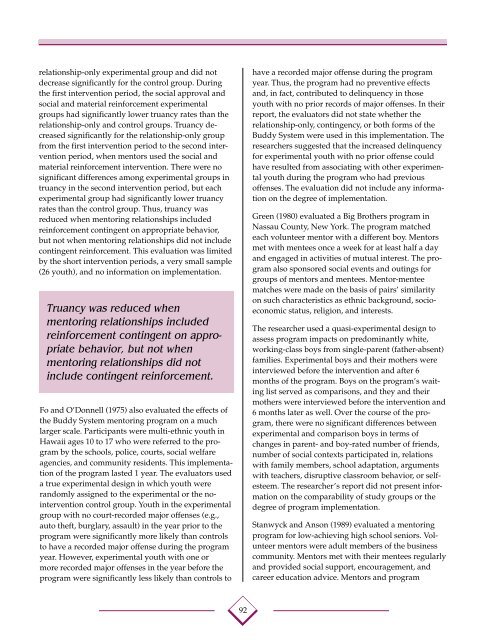uide for Implementing the Comprehensive Strategy for Serious ...
uide for Implementing the Comprehensive Strategy for Serious ...
uide for Implementing the Comprehensive Strategy for Serious ...
Create successful ePaper yourself
Turn your PDF publications into a flip-book with our unique Google optimized e-Paper software.
elationship-only experimental group and did not<br />
decrease significantly <strong>for</strong> <strong>the</strong> control group. During<br />
<strong>the</strong> first intervention period, <strong>the</strong> social approval and<br />
social and material rein<strong>for</strong>cement experimental<br />
groups had significantly lower truancy rates than <strong>the</strong><br />
relationship-only and control groups. Truancy decreased<br />
significantly <strong>for</strong> <strong>the</strong> relationship-only group<br />
from <strong>the</strong> first intervention period to <strong>the</strong> second intervention<br />
period, when mentors used <strong>the</strong> social and<br />
material rein<strong>for</strong>cement intervention. There were no<br />
significant differences among experimental groups in<br />
truancy in <strong>the</strong> second intervention period, but each<br />
experimental group had significantly lower truancy<br />
rates than <strong>the</strong> control group. Thus, truancy was<br />
reduced when mentoring relationships included<br />
rein<strong>for</strong>cement contingent on appropriate behavior,<br />
but not when mentoring relationships did not include<br />
contingent rein<strong>for</strong>cement. This evaluation was limited<br />
by <strong>the</strong> short intervention periods, a very small sample<br />
(26 youth), and no in<strong>for</strong>mation on implementation.<br />
Truancy was reduced when<br />
mentoring relationships included<br />
rein<strong>for</strong>cement contingent on appropriate<br />
behavior, but not when<br />
mentoring relationships did not<br />
include contingent rein<strong>for</strong>cement.<br />
Fo and O’Donnell (1975) also evaluated <strong>the</strong> effects of<br />
<strong>the</strong> Buddy System mentoring program on a much<br />
larger scale. Participants were multi-ethnic youth in<br />
Hawaii ages 10 to 17 who were referred to <strong>the</strong> program<br />
by <strong>the</strong> schools, police, courts, social welfare<br />
agencies, and community residents. This implementation<br />
of <strong>the</strong> program lasted 1 year. The evaluators used<br />
a true experimental design in which youth were<br />
randomly assigned to <strong>the</strong> experimental or <strong>the</strong> nointervention<br />
control group. Youth in <strong>the</strong> experimental<br />
group with no court-recorded major offenses (e.g.,<br />
auto <strong>the</strong>ft, burglary, assault) in <strong>the</strong> year prior to <strong>the</strong><br />
program were significantly more likely than controls<br />
to have a recorded major offense during <strong>the</strong> program<br />
year. However, experimental youth with one or<br />
more recorded major offenses in <strong>the</strong> year be<strong>for</strong>e <strong>the</strong><br />
program were significantly less likely than controls to<br />
92<br />
have a recorded major offense during <strong>the</strong> program<br />
year. Thus, <strong>the</strong> program had no preventive effects<br />
and, in fact, contributed to delinquency in those<br />
youth with no prior records of major offenses. In <strong>the</strong>ir<br />
report, <strong>the</strong> evaluators did not state whe<strong>the</strong>r <strong>the</strong><br />
relationship-only, contingency, or both <strong>for</strong>ms of <strong>the</strong><br />
Buddy System were used in this implementation. The<br />
researchers suggested that <strong>the</strong> increased delinquency<br />
<strong>for</strong> experimental youth with no prior offense could<br />
have resulted from associating with o<strong>the</strong>r experimental<br />
youth during <strong>the</strong> program who had previous<br />
offenses. The evaluation did not include any in<strong>for</strong>mation<br />
on <strong>the</strong> degree of implementation.<br />
Green (1980) evaluated a Big Bro<strong>the</strong>rs program in<br />
Nassau County, New York. The program matched<br />
each volunteer mentor with a different boy. Mentors<br />
met with mentees once a week <strong>for</strong> at least half a day<br />
and engaged in activities of mutual interest. The program<br />
also sponsored social events and outings <strong>for</strong><br />
groups of mentors and mentees. Mentor-mentee<br />
matches were made on <strong>the</strong> basis of pairs’ similarity<br />
on such characteristics as ethnic background, socioeconomic<br />
status, religion, and interests.<br />
The researcher used a quasi-experimental design to<br />
assess program impacts on predominantly white,<br />
working-class boys from single-parent (fa<strong>the</strong>r-absent)<br />
families. Experimental boys and <strong>the</strong>ir mo<strong>the</strong>rs were<br />
interviewed be<strong>for</strong>e <strong>the</strong> intervention and after 6<br />
months of <strong>the</strong> program. Boys on <strong>the</strong> program’s waiting<br />
list served as comparisons, and <strong>the</strong>y and <strong>the</strong>ir<br />
mo<strong>the</strong>rs were interviewed be<strong>for</strong>e <strong>the</strong> intervention and<br />
6 months later as well. Over <strong>the</strong> course of <strong>the</strong> program,<br />
<strong>the</strong>re were no significant differences between<br />
experimental and comparison boys in terms of<br />
changes in parent- and boy-rated number of friends,<br />
number of social contexts participated in, relations<br />
with family members, school adaptation, arguments<br />
with teachers, disruptive classroom behavior, or selfesteem.<br />
The researcher’s report did not present in<strong>for</strong>mation<br />
on <strong>the</strong> comparability of study groups or <strong>the</strong><br />
degree of program implementation.<br />
Stanwyck and Anson (1989) evaluated a mentoring<br />
program <strong>for</strong> low-achieving high school seniors. Volunteer<br />
mentors were adult members of <strong>the</strong> business<br />
community. Mentors met with <strong>the</strong>ir mentees regularly<br />
and provided social support, encouragement, and<br />
career education advice. Mentors and program

















